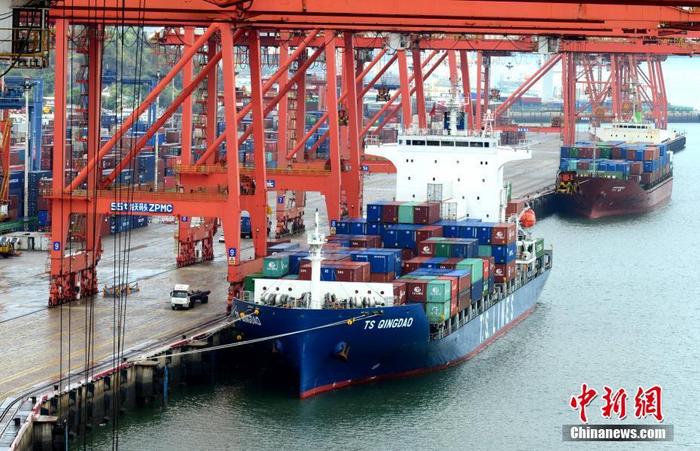(Economic Observer) Why does China, which has signed RCEP, still actively consider CPTPP?
China News Service, Beijing, December 18 (Chen Jing and Zhang Wenhui) After the signing of the Regional Comprehensive Economic Partnership (RCEP), the Central Economic Work Conference held on the 16th to 18th proposed that it is necessary to actively consider joining the Comprehensive and Progressive Trans-Pacific Partnership Relationship Agreement (CPTPP).
Data map: Port container terminal.
Photo by China News Agency reporter Wang Dongming
Zhao Ping, deputy dean and researcher of the Research Institute of China Council for the Promotion of International Trade, said in an interview with China News Agency that according to the "14th Five-Year Plan", during the "14th Five-Year Plan" period, China will implement a free trade zone promotion strategy and build a global-oriented High-standard free trade zone network.
That is to say, on the one hand, it is necessary to carry out upgrade negotiations on the original free trade agreement and upgrade in accordance with higher standards to increase the level of openness of the free trade zone; on the other hand, it is necessary to participate in higher standard free trade agreement negotiations to expand freedom. Coverage of the trade zone network.
Zhao Ping said that the predecessor of CPTPP is the Trans-Pacific Partnership Agreement (TPP). CPTPP basically retains 95% of the terms of the TPP. It is an open, transparent, mutually beneficial and win-win regional free trade arrangement, and it is also the world's highest standard free trade agreement.
"China's active consideration of joining the CPTPP means that it will promote domestic reform and development with a higher level of opening up. It not only points out the direction of China's expansion of the free trade zone network, but also reflects China's spirit of opening up to the end, and it also explains China's external Opening up will continue to go in a larger, broader, and deeper direction." Zhao Ping said.
Zhang Jianping, director of the Research Center for Regional Economic Cooperation of the Chinese Academy of Commerce, said in an interview with China News Agency that CPTPP has 30 chapters, which cover a large number of domestic economic management systems, management rules, especially labor standards, environmental protection, Government procurement, intellectual property protection, competition policy, ISDS companies’ complaints to the government, digital economy, state-owned enterprise regulation, and industrial subsidies.
In the field of trade, it is close to 99% of zero tariff; in the field of service trade and investment, the management model of negative list is adopted.
What are the obstacles for China to join CPTPP?
Zhang Jianping believes that, judging from the relevant provisions of China's current accession to RCEP, the positive list of commitments is still adopted in the field of service trade, and there is still a big gap between the opening up of China's service industry and the CPTPP rules.
There is also a certain gap between the level of liberalization of China's trade in goods and CPTPP.
Therefore, Zhang Jianping believes that these issues require China to adopt a new round of reform and opening up to promote institutional opening to the outside world, especially in the pilot free trade zone, and gradually improve the economic and trade management methods and institutional arrangements to make it compatible with 21 The trade and investment rule system of the century is gradually connected.
Actively considering joining CPTPP, what should be done?
Yu Miaojie, Secretary of the Party Committee and Deputy Dean of the National Development Research Institute of Peking University, suggested in an interview with China News Agency:
First, in terms of commodity trade, further reduce import tariffs, and try to emphasize China’s implementation of regional accumulative origin standards in the negotiations, while doing a good job in trade facilitation and investment facilitation, optimizing the business environment, and reducing import imports. Related costs, etc.
The second is to comprehensively promote the negative list model in service trade to promote the opening of China's service trade.
Third, in terms of investment, we should learn from the pre-access national treatment plus negative list model adopted by China in the pilot free trade zone and promote it nationwide in an orderly manner.
The fourth is to do a good job in intellectual property protection, encourage enterprises to innovate, and narrow the gap with developed countries in core key areas, which will help China further join the CPTPP.
(Finish)

